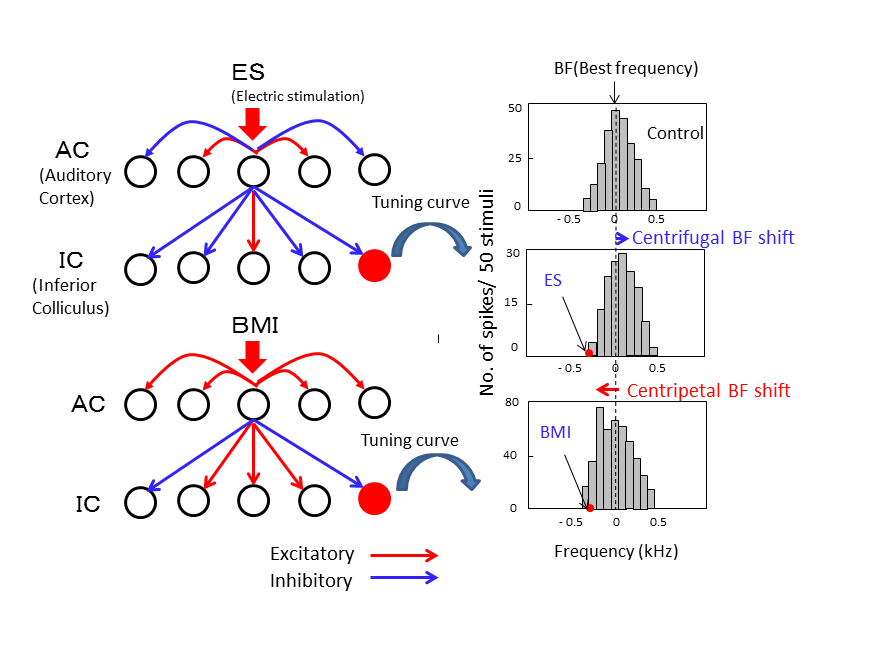Topics - Press Release
Modelling auditory systems of bats for information processing
Scientists have developed a neural network model of a bat's auditory system to understand how bats rapidly discriminate between signals from edible insects and surrounding background noise. The report by researchers at UEC, Tokyo is published Neural Processing Letters.
An intriguing aspect of auditory signal processing is that certain creatures can tune in to specific frequencies relevant to behavior - such as for hunting or survival - while filtering out all other 'noise'. Scientists know that, while sensory information is transmitted from the ears to the cerebral cortex in a 'feedforward' manner, the information is also modulated by feedback from the cerebral cortex itself. Cortical neurons are excited by relevant signals, and tell the peripheral neurons to hone in on them while at the same time reducing signals from surrounding noise - a 'gating' mechanism, in other words. However, exactly how this process works is unclear.
Kazuhisa Fujita and Yoshiki Kashimori at the University of Electro-Communications in Tokyo, Japan, developed a neural network model of a bat's auditory system to examine how signal processing may be modulated by feedback from the cerebral cortex1.
Bats hunt by echolocation, and this involves detecting the Doppler-shifted frequency of sound echoes (as prey moves). Following feedback from cortical neurons, certain neurons in the auditory cortex are electrically stimulated by Doppler-shifted frequencies while others are not. This stimulation evokes synaptic modulation in neurons in the inferior colliculus (an area in the midbrain).
Fujita and Kashimori's model shows how an injection of GABA antagonist bicuculline methidide, or BMI, enhances signals from surrounding 'noise' picked up by other auditory neurons. The electrical stimulation from a relevant signal coupled with GABAergic inhibition enables the bats to balance activity in different neurons' receptive fields.
Their model could help understand how bats rapidly discriminate between signals from edible insects and surrounding background noise.
Reference
-
Authors: K. Fujita and Y. Kashimori
Title of paper: Neural mechanism of corticofugal modulation of tuning property in frequency domain of bat's auditory system.
Journal: Neural Processing Letters 43, pp 537-551, (2016).
http://link.springer.com/article/10.1007/s11063-015-9425-6

Further information
International Public Relations
The University of Electro-Communications
1-5-1 Chofugaoka, Chofu, Tokyo 182-8585
- E-mail:
- Website:
- http://www.uec.ac.jp/eng/
- UEC Research Portal:
- http://www.ru.uec.ac.jp/
About The University of Electro-Communications
The University of Electro-Communications (UEC) in Tokyo is a small, luminous university at the forefront of applied sciences, engineering, and technology research. Its roots go back to the Technical Institute for Wireless Commutations, which was established in 1918 by the Wireless Association to train so-called wireless engineers in maritime communications in response to the Titanic disaster in 1912. In 1949, the UEC was established as a national university by the Japanese Ministry of Education, and moved in 1957 from Meguro to its current Chofu campus Tokyo.
With approximately 4,000 students and 350 faculty, UEC is regarded as a small university, but with particular expertise in wireless communications, laser science, robotics, informatics, and material science, to name just a few areas of research.
The UEC was selected for the Ministry of Education, Culture, Sports, Science and Technology (MEXT) Program for Promoting the Enhancement of Research Universities as a result of its strengths in three main areas: optics and photonics research, where we are number one for the number of joint publications with foreign researchers; wireless communications, which reflects our roots; and materials-based research, particularly on fuel cells.
Website: http://www.uec.ac.jp/eng/

